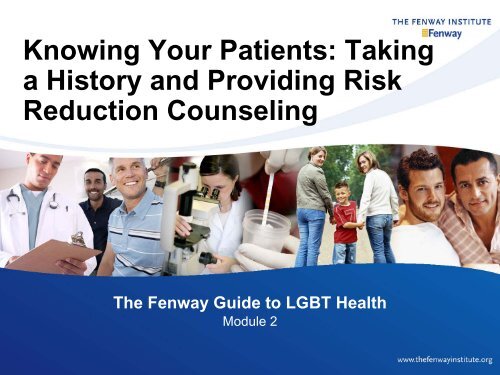Knowing Your Patients: Taking a History and ... - Fenway Health
Knowing Your Patients: Taking a History and ... - Fenway Health
Knowing Your Patients: Taking a History and ... - Fenway Health
You also want an ePaper? Increase the reach of your titles
YUMPU automatically turns print PDFs into web optimized ePapers that Google loves.
<strong>Knowing</strong> <strong>Your</strong> <strong>Patients</strong>: <strong>Taking</strong><br />
a <strong>History</strong> <strong>and</strong> Providing Risk<br />
Reduction Counseling<br />
The <strong>Fenway</strong> Guide to LGBT <strong>Health</strong><br />
Module 2
2<br />
Learning Objectives<br />
At the end of this module, participants will be able to:<br />
� Apply approaches to taking a comprehensive history with<br />
lesbian, gay, bisexual, <strong>and</strong> transgender (LGBT) patients<br />
� Apply approaches to taking a sensitive <strong>and</strong> thorough<br />
sexual history<br />
� Apply methods for providing relevant sexual risk reduction<br />
counseling
3<br />
<strong>Taking</strong> a Comprehensive <strong>History</strong><br />
� The core comprehensive<br />
history for LGBT patients is<br />
the same as for all patients<br />
� Varies regarding setting<br />
� Reason for coming<br />
� Social <strong>and</strong> sexual history<br />
� Past medical history<br />
� Review lifestyle risk factors
4<br />
Getting to Know your Patient<br />
� Get to know your patient as a person (e.g., partners,<br />
children, jobs)<br />
� Validates LGBT lives as normal <strong>and</strong> not focused on sexual<br />
behavior<br />
� Helps assess social adjustment <strong>and</strong> community support<br />
� Ask open-ended questions<br />
� Tell me about yourself<br />
� Who lives in your home with you?<br />
� Are you involved in a relationship?<br />
� What kind of work do you do?<br />
� You may learn a lot of what you need to know to guide the<br />
rest of the history
5<br />
Using a Cross-Cultural Approach<br />
to Care<br />
� Ask questions that are inclusive <strong>and</strong> do not assume heterosexuality<br />
� Ask questions that are non-judgmental <strong>and</strong> open-ended<br />
� Be curious, respectful <strong>and</strong> empathic<br />
� Use gender-neutral language when referring to partners<br />
� Avoid using any identity term prior to hearing it from your patient<br />
� Listen to how your patients describe themselves <strong>and</strong> their partners,<br />
<strong>and</strong> follow their lead (unless terms sound derogatory)<br />
� If you are not sure what terminology to use, ask your patient!
6<br />
Talking with <strong>Patients</strong><br />
� Instead of “Are you married?” or “Do you have a<br />
boyfriend/girlfriend” ask:<br />
� “Do you have a partner or spouse?”<br />
� “Are you currently in a relationship?”; if yes, “Tell me about it.”<br />
� If a female patient refers to her wife, clinician should also say<br />
wife, even if couple is not legally married<br />
� If a male patient has sex with men but does not refer to himself<br />
as “gay,” the clinician should not use the term “gay”. Patient<br />
may consider himself heterosexual or bisexual.
7<br />
Identified LGBT <strong>Health</strong> Concerns<br />
� Smoking<br />
� Substance abuse<br />
� Violence (domestic, hate crimes)<br />
� HIV, STIs, <strong>and</strong> viral hepatitis<br />
�Depression, anxiety, suicidal behavior<br />
� Cancers (anal cancer in men, lower screening<br />
rates for breast, cervical cancer in women)<br />
� Obesity (lesbians)<br />
� Eating disorders (gay men)
8<br />
LGBT <strong>Health</strong> Concerns: Sample<br />
Questions<br />
� Do you smoke? How many cigarettes do you smoke per<br />
day? Have you ever tried quitting?<br />
� On average, how many drinks of alcohol do you have per<br />
week?<br />
� Do you struggle at all with depression or feeling down? Do<br />
you struggle with anxiety?<br />
� Do you follow a special diet?<br />
� Have you ever binged, purged, or restricted your food<br />
intake?<br />
� At any time, has anyone hit, kicked, choked, threatened,<br />
forced him or herself on you sexually, touched you in a<br />
sexual way that was unwanted, or otherwise hurt or<br />
frightened you?
9<br />
LGBT Life Issues<br />
� Process of coming out as LGBT<br />
� Stigma of living as LGBT (e.g., rejection from family)<br />
� Partnering (marriage, civil unions, other commitment)<br />
� Becoming parents (adoption, insemination, etc.)<br />
� End-of-life/advance directives<br />
� Discrimination in housing, work, children’s education<br />
� Clinicians should:<br />
• Ask questions <strong>and</strong> listen without judgment or bias<br />
• Be prepared to make referrals
<strong>Taking</strong> a Sexual <strong>History</strong><br />
10
11<br />
<strong>Taking</strong> a Sexual <strong>History</strong><br />
Contextualize a sexual history, emphasizing that it is<br />
routine with all patients <strong>and</strong> confidential.<br />
� Now I am going to ask you some questions about your<br />
sexual health. These questions are very personal, but are<br />
important for me to know to help keep you healthy. I ask<br />
these questions of all my patients, <strong>and</strong> they are just as<br />
important as questions about your overall physical <strong>and</strong><br />
mental health. Like the rest of this visit, this information is<br />
strictly confidential.
<strong>Taking</strong> a Sexual <strong>History</strong>:<br />
Behavior, Identity <strong>and</strong> Desire<br />
� Ask if patient is sexually active:<br />
� Have you been sexually involved with anyone during the past year,<br />
including oral, vaginal, or anal sex, or other kinds of sexual practices?<br />
� If no, ask about past sexual partners:<br />
� Have you ever been sexually involved with men, women, or both?<br />
� If yes, ask about current sexual partners:<br />
� Are you sexually involved with women, men, or both?<br />
� How many sexual partners have you had in the last year?<br />
� Assess patient comfort with sexual identity <strong>and</strong> desire<br />
� Do you have any sexual concerns or questions you’d like to discuss?<br />
� Do you have any concerns or questions about your sexuality? Sexual<br />
identity? Or sexual desires?<br />
� Are your sexual desires for men, women, or both?<br />
� Do you feel comfortable with your sexuality <strong>and</strong> sexual identity?<br />
� Use language mirroring the patient’s language<br />
12
<strong>Taking</strong> a Sexual <strong>History</strong>: Sexual<br />
<strong>Health</strong><br />
� Assess risk for sexually transmitted infections (STIs) <strong>and</strong><br />
pregnancy (if relevant)<br />
13<br />
� How do you protect yourself from HIV <strong>and</strong> other STIs?<br />
� …from unplanned pregnancy (if relevant)?<br />
� If use condoms or latex dams, ask: How often do you use<br />
condoms or latex dams when you have sex: all the time, most of<br />
the time, once in a while?<br />
� If barrier use is not consistent, ask: When <strong>and</strong> with whom do you<br />
not use condoms or latex dams?<br />
� Have you ever been diagnosed with gonorrhea, chlamydia,<br />
syphilis, trichomonas, HIV, hepatitis, or another STI?<br />
� Has your partner(s) …?<br />
� Do you use alcohol or any drugs when you have sex, such as<br />
crystal meth, cocaine, ecstasy, poppers, injection drugs, Viagra,<br />
others?
14<br />
<strong>Taking</strong> a Sexual <strong>History</strong>, cont’d<br />
� For men who have sex with men, assess additional<br />
disease prevention practices:<br />
� Have you ever had hepatitis B, or ever gotten the hepatitis B<br />
vaccine (all 3 doses)?<br />
� Have you ever had hepatitis A, or ever gotten the hepatitis A<br />
vaccine (2 doses)?<br />
� Have you ever had an anal Pap smear (to check for anal HPV<br />
infection <strong>and</strong> possible progression to dysplasia or anal<br />
cancer)?<br />
� Have you ever been tested for syphilis?
15<br />
<strong>Taking</strong> a Sexual <strong>History</strong>, cont’d<br />
� Assess sexual function<br />
� Do you have any concerns about sexual function?<br />
� Do you have any pain or discomfort during intercourse (anal or<br />
vaginal)?<br />
� Do you have any problems with erection? Ejaculation? Orgasm?<br />
� Have you had any change in sexual desire?<br />
� Assess sexual trauma/violence victimization if not covered<br />
during earlier history<br />
� Has anyone ever forced him or herself on you sexually, or touched<br />
you in a sexual way that was unwanted?
Avoid Assumptions; Be Open To<br />
What <strong>Patients</strong> May Tell You!<br />
16<br />
� Sexual behavior, desire, <strong>and</strong> identity do not always align<br />
• A patient who identifies as straight may have (or desire to have)<br />
same-sex partners<br />
• A patient who identifies as gay may have different-sex partners<br />
• A patient who identifies as bisexual may have only same-sex or<br />
only different-sex partners<br />
� Sexual behavior <strong>and</strong> identity can change over time<br />
� Sex outside committed relationships happens<br />
� Some committed relationships may be with more than one<br />
person<br />
� Elderly people have sex<br />
� “Sex” has different meanings to different people (be<br />
specific)
Considerations for Transgender<br />
<strong>Patients</strong><br />
� Gender identity is distinct from sexual orientation (don’t assume<br />
transgender people are gay, lesbian, bisexual, etc.)<br />
� Transgender people express the same range of sexual behavior <strong>and</strong><br />
identity as non-transgender people<br />
� Ask about any gender confirmation surgery to help assess sexual risk<br />
behaviors <strong>and</strong> to guide your physical examination; do not make<br />
assumptions based on stated identity or external appearances<br />
� <strong>Your</strong> examination should focus on organs that are present; however,<br />
note that some people who have retained original sexual organs, where<br />
these organs may be inconsistent with their gender identity, may be<br />
extra sensitive to questions about sexual practices <strong>and</strong> examination of<br />
these organs. The same may be true of questions <strong>and</strong> examination of<br />
breasts.<br />
� Do not hesitate to ask your patients for clarification of certain terms or<br />
behaviors. Let them teach you!<br />
17
Considerations for Bisexual<br />
<strong>Patients</strong><br />
18<br />
� Bisexual people may be in a committed relationship, casual<br />
relationship(s), or have no relationship, <strong>and</strong> may have sex one-on-one<br />
(more common) or in a group (less common)<br />
� Someone who identifies as bisexual has not always had a sexual<br />
relationship with both same <strong>and</strong> opposite-gender partners<br />
� Someone who has sex with partners of more than one gender does not<br />
always identify as bisexual<br />
� Approach each patient as an individual, avoiding any assumptions, <strong>and</strong><br />
using the history to get accurate information about sexual practices
19<br />
Confidentiality<br />
� Assure patients that all information is confidential.<br />
� If a patient expresses concern about their sexual orientation,<br />
behaviors, or gender identity during the history, provide<br />
affirmation after they disclose information:<br />
� “I’m glad you told me this.”<br />
� “I know this wasn’t easy for you to tell me, <strong>and</strong> I appreciate your honesty.”<br />
� If patient worries that sensitive information is going in their<br />
medical record, explain the following:<br />
� Which information you believe is clinically relevant to include in the record<br />
for continuity of care <strong>and</strong> good medical practice,<br />
� Who has access to medical records, <strong>and</strong><br />
� What the privacy protections are for medical records in your practice.<br />
� It may be best to not document the patient’s sexuality or<br />
transgender identity if doing so would prevent them from being<br />
forthright.
Providing Sexual Risk Reduction<br />
Counseling <strong>and</strong> Discussing HIV<br />
Testing<br />
20
Principles of Safer Sex<br />
� Assess patient’s risk <strong>and</strong> risk-taking behaviors with a<br />
thorough history<br />
� Assess patient’s perception of risk for STIs, HIV<br />
� Guide patient toward appropriate prevention strategies<br />
using a harm reduction approach (see next slide), based on<br />
individual readiness for change <strong>and</strong> comfort with risk<br />
21
Principles of Safer Sex, cont’d<br />
� Examples of behavioral risk reduction approaches<br />
� Abstinence<br />
� Monogamy with uninfected partner<br />
� Reduce number of partners<br />
� Low-risk sexual practices<br />
� Consistent <strong>and</strong> correct use of barrier methods<br />
� Cease engaging in one form of high-risk activity<br />
� Avoid excessive substance use<br />
� Advise patients to have a proactive plan to protect<br />
themselves <strong>and</strong> partners<br />
� Counsel on correct use of barrier protection<br />
� Educate on availability of post-exposure prophylaxis (PEP)<br />
for high-risk HIV exposure (e.g. condom break, post-coital<br />
HIV disclosure)<br />
22
23<br />
Magnitude of Risk<br />
Sexual Contact Type Risks<br />
Unprotected intercourse: High risk of:<br />
anal-receptive<br />
HIV, gonorrhea, chlamydia, HPV,<br />
anal-insertive<br />
herpes, syphilis, hepatitis B,<br />
vaginal-penile<br />
trichomonas (vaginal-penile only)<br />
Unprotected oral intercourse Reported risk of HIV<br />
Risk of: HPV, herpes, syphilis,<br />
gonorrhea, chlamydia<br />
Note: pharyngeal as well as genital<br />
infection possible<br />
Unprotected oral-anal contact Risk of: hepatitis A, intestinal<br />
parasites, enteric infections
24<br />
Magnitude of Risk, cont’d<br />
Sexual Contact Type Risks<br />
Unprotected sexual contact between<br />
women<br />
Sharing sex toys<br />
Digital-genital contact<br />
Vagina-vagina contact<br />
Risk of: HPV, bacterial<br />
vaginosis, genital herpes,<br />
chlaymdia, trichomonas, HIV<br />
Wet (French) kissing No known risk of HIV<br />
Risk of herpes (HSV-1)
Common Misconceptions about Risk<br />
� I can’t get HIV/STIs if I am the “top” (insertive partner in<br />
anal sex)<br />
� I can’t get STIs from oral sex<br />
� [for HIV- men]<br />
� I don’t need to use condoms with HIV- partners<br />
� My partner didn’t say he’s HIV+, so he must be HIV-<br />
� I don’t need to use condoms with an HIV+ partner if he is taking<br />
anti-retrovirals <strong>and</strong> his viral load is undetectable<br />
� [for HIV+ men]<br />
� I don’t need to use condoms with HIV+ partners<br />
� My partner didn’t want to use a condom, so he must be HIV+<br />
� Lesbians are at low risk of STIs <strong>and</strong> therefore I don’t need<br />
to use protection<br />
25
Safer Sex Education <strong>and</strong><br />
Counseling: Women who have<br />
Sex with Women (WSW)<br />
� Many WSW also have (or have had) sex with men,<br />
increasing risk of HIV infection <strong>and</strong> STIs<br />
� Higher risk than heterosexual women of bacterial vaginosis<br />
� Other higher risk STIs between women: herpes, HPV,<br />
trichomonas, yeast infections<br />
� Counseling can focus on minimizing sexual transfer of<br />
vaginal fluids <strong>and</strong> menstrual blood<br />
� Latex barriers (gloves, dental dams for oral-vaginal or oral-anal sex,<br />
condoms with insertive objects/sex toys that are shared)<br />
� Lubricants to reduce tearing, abrasions<br />
� Clean insertive objects/sex toys with 1/10 th bleach/water solution<br />
after use<br />
26





